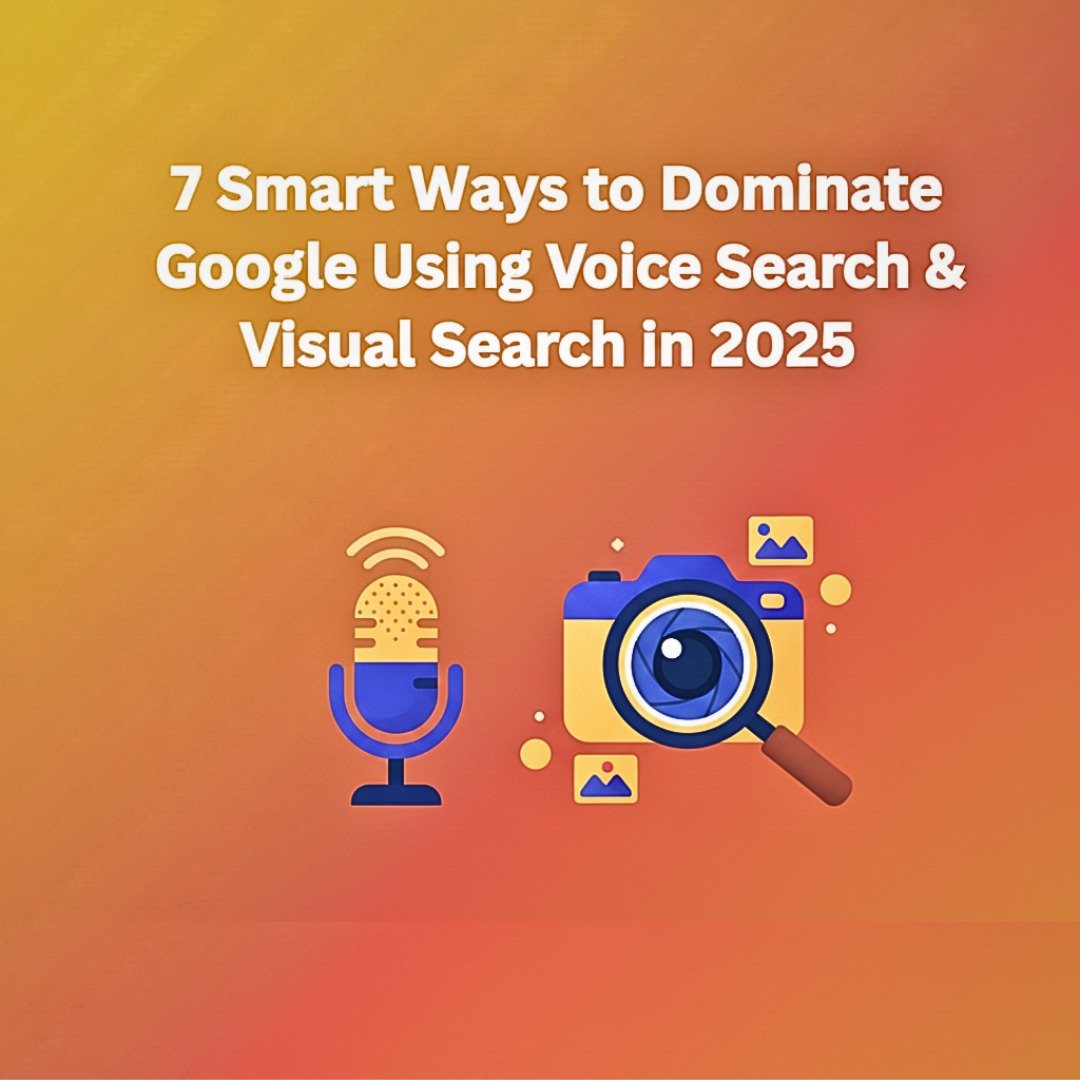Voice Search and Visual Search are no longer futuristic ideas. They are reshaping how users interact with information online. In 2025, people are speaking, snapping, and scanning more than ever to find products, services, and answers. For businesses and marketers, this evolution means a new set of strategies to stay visible, relevant, and competitive on Google.
Let’s explore 7 smart ways to dominate Google using Voice Search and Visual Search this year with practical tips you can start implementing today
1, Optimise for Conversational Keywords
When users perform a voice search, they do not type short keywords like best dentist Kochi. They ask full questions such as Who is the best dental clinic near me? or Which is the top hair salon in Kalamassery?
That is why long-tail, conversational keywords are essential. Instead of focusing only on short phrases like dental clinic Kochi, include natural, question-based sentences:
Where can I get affordable braces in Kochi
Which is the best hair salon for kids near Kalamassery
What is the best place for birthday balloon decoration in Delhi
Smart Tip:
Use tools like AnswerThePublic, AlsoAsked, and Google’s People Also Ask section to find real voice-style queries. Create FAQ sections and blog headings in a conversational tone.
Why It Works:
Google’s algorithms now prioritise natural language and context. By mirroring how people actually speak, your content becomes more voice-friendly and ranks higher for question-based searches.
2, Strengthen Local SEO for “Near Me” Searches
Voice search is deeply local. Most people using voice commands are looking for something nearby such as a dentist near me, event planner in Kochi, or best coconut drink shop near me.
To capture this audience, you need a strong local SEO foundation:
Claim and optimise your Google Business Profile (GMB).
Add accurate business details such as address, phone number, and working hours.
Include location-based keywords naturally in your website content.
Encourage happy customers to leave Google reviews with relevant keywords such as Aide Groups French classes in Kochi.
Smart Tip:
Embed local schema markup on your website to help Google better understand your business details for local voice and visual search results.
Why It Works:
When users ask Hey Google, where can I find…, your optimised local presence boosts visibility on Google Maps and voice search results.
3, Build Content That Answers Specific Questions
Voice assistants like Google Assistant, Siri, and Alexa are designed to deliver quick answers, not just links. If your content directly answers questions, Google is more likely to feature it in position zero which is the featured snippet spot.
To achieve this, create content around who, what, when, where, why, and how questions related to your niche.
For example:
How does a dental aligner work
Why should you choose event professionals for your wedding
What makes pink coconut water healthy
Smart Tip:
Use short, clear paragraphs of 40 to 60 words to answer each question. Add visuals, bullet points, or numbered lists for easy readability.
Why It Works:
Featured snippets are the top source of voice assistant answers. When your content is concise and relevant, Google is more likely to use it for spoken search results.
4, Embrace Image Optimisation for Visual Search
Visual search allows users to upload or capture images to find similar products or information. Platforms such as Google Lens, Pinterest Lens, and Bing Visual Search are growing rapidly in 2025.
To rank higher in visual search results, ensure your images are SEO-ready:
Use high-resolution, original photos.
Name images with descriptive keywords such as pink-coconut-drink-UAE.jpg.
Add alt text describing the image content naturally.
Use structured data (imageObject) to help Google index visuals correctly.
Smart Tip:
Create visual-heavy content such as infographics, product carousels, and how-to images to increase visibility in Google Lens and image search.
Why It Works:
Visual search is becoming a new discovery engine. Well-optimised images attract users who prefer to see products instead of typing queries.
5, Improve Page Speed and Mobile Optimisation
Both voice and visual searches are dominated by mobile users, and Google rewards fast, mobile-friendly websites. A slow or poorly designed site can hurt your ranking chances.
Make sure your site loads in under 3 seconds. Compress images, use a reliable hosting provider, and switch to a mobile-first design. Test performance with Google PageSpeed Insights and Core Web Vitals.
Smart Tip:
Implement AMP (Accelerated Mobile Pages) for blogs and landing pages. This ensures fast loading and better visibility on mobile results.
Why It Works:
Fast, responsive websites improve user experience, reduce bounce rates, and help search engines prioritise your content for mobile and voice searches.
6, Use Structured Data and Schema Markup
Google relies on structured data to understand your website content contextually. For both voice and visual search, schema markup gives Google precise signals about your business, products, and services.
Common schema types that help include:
FAQ schema to improve your content for voice answers.
Local business schema to enhance location relevance.
Product schema to make your items appear in Google Shopping and visual results.
HowTo schema for step-by-step tutorials that show in both voice and visual searches.
Smart Tip:
Use tools like Schema.org, Google’s Structured Data Markup Helper, or RankMath SEO plugin to apply schema easily.
Why It Works:
Schema improves Google’s understanding of your site, helping it appear in rich results, featured snippets, and image carousels which attract more clicks and visibility.
Combine Video Content , Voice Search and Visual Search for Maximum Reach
The smartest marketers in 2025 are not choosing between formats. They are integrating them.Video search , Voice Search & Visual Search work together to capture attention across platforms.
Add voice-friendly scripts in video descriptions and captions.
Use thumbnails and titles with visual cues for Google Lens discovery.
Create YouTube Shorts answering common voice search queries such as How to plan a budget wedding in Kochi.
Repurpose blog FAQs into short-form videos or Instagram Reels for omnichannel visibility.
Smart Tip:
Add transcripts and alt text to videos. These elements help search engines understand content better and improve discoverability across both voice and visual algorithms.
Why It Works:
Google is increasingly connecting multimedia content. A page that satisfies voice queries and aligns with Voice Search and Visual Search signals ranks higher across all search formats.
Conclusion: The Future of Search is Voice Search and Visual Search
Voice Search and Visual Search are redefining how people explore the web. They make discovery faster, more intuitive, and more personal. By optimising for natural speech, local context, structured data, mobile experience, and rich visuals, your brand can own prime space on Google’s evolving search results.
As 2025 progresses, businesses that embrace smart search technologies by combining AI, creativity, and SEO will lead the digital race. Start now and let every Voice Search and Visual Search guide users straight to your brand.


